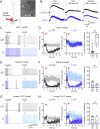Phylogenetic divergence of GABAB receptor signaling in neocortical networks over adult life
- PMID: 40328769
- PMCID: PMC12056048
- DOI: 10.1038/s41467-025-59262-8
Phylogenetic divergence of GABAB receptor signaling in neocortical networks over adult life
Abstract
Cortical circuit activity is controlled by GABA-mediated inhibition in a spatiotemporally restricted manner. GABAB receptor (GABABR) signalling exerts powerful slow inhibition that controls synaptic, dendritic and neuronal activity. But, how GABABRs contribute to circuit-level inhibition over the lifespan of rodents and humans is poorly understood. In this study, we quantitatively determined the functional contribution of GABABR signalling to pre- and postsynaptic domains in rat and human cortical principal cells. We find that postsynaptic GABABR differentially control pyramidal cell activity within the cortical column as a function of age in rodents, but minimally change over adult life in humans. Presynaptic GABABRs exert stronger inhibition in humans than rodents. Pre- and postsynaptic GABABRs contribute to co-ordination of local information processing in a layer- and species-dependent manner. Finally, we show that GABABR signalling is elevated in patients that have received the anti-seizure medication Levetiracetam. These data directly increase our knowledge of translationally relevant local circuit dynamics, with direct impact on understanding the role of GABABRs in the treatment of seizure disorders.
© 2025. The Author(s).
Conflict of interest statement
Competing interests: The authors declare no competing interests.
Figures








References
-
- Mody, I. & Pearce, R. A. Diversity of inhibitory neurotransmission through GABAA receptors. Trends Neurosci.27, 569–575 (2004). - PubMed
-
- Princivalle, A., Duncan, J., Thom, M. & Bowery, N. GABAB1a, GABAB1b and GABAB2 mRNA variants expression in hippocampus resected from patients with temporal lobe epilepsy. Neuroscience122, 975–984 (2003). - PubMed
-
- Teichgräber, L. A. et al. Impaired function of GABAB receptors in tissues from pharmacoresistant epilepsy patients. Epilepsia50, 1697–1716 (2009). - PubMed
-
- Sheilabi, M. A. et al. Quantitative expression and localization of GABAB receptor protein subunits in hippocampi from patients with refractory temporal lobe epilepsy. Neuropharmacology136, 117–128 (2018). - PubMed
-
- Schuler, V. et al. Epilepsy, hyperalgesia, impaired memory, and loss of pre-and postsynaptic GABAB responses in mice lacking GABAB. Neuron31, 47–58 (2001). - PubMed
MeSH terms
Substances
LinkOut - more resources
Full Text Sources

